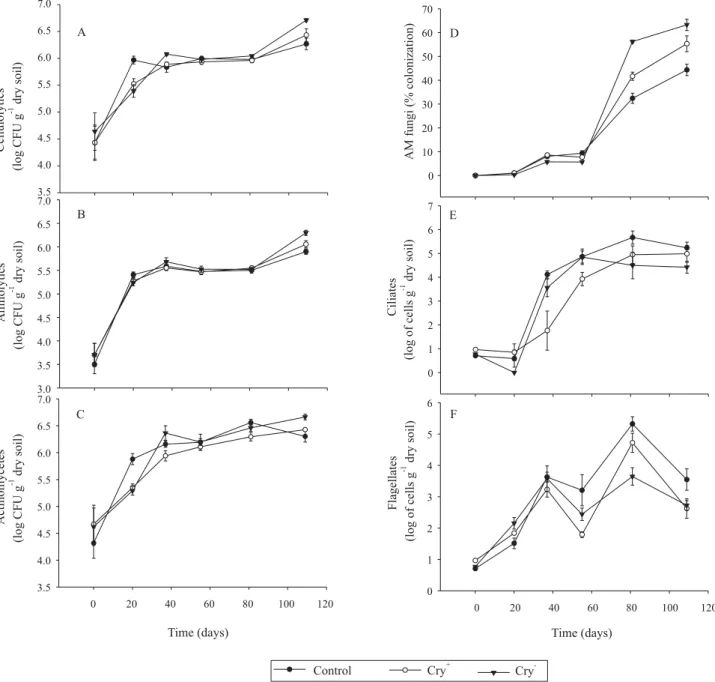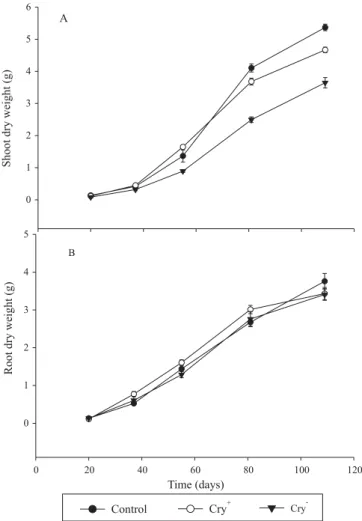Notas Científicas
Effect of
Bacillus thuringiensis
on microbial functional groups
in sorghum rhizosphere
Carlos Brasil(1), Leopoldo Sussumu Matsumoto(1), Marco Antonio Nogueira(1), Flavia Regina Spago(1),
Luís Gustavo Rampazo(1), Marcio Ferreira Cruz(1) and Galdino Andrade(1)
(1)Universidade Estadual de Londrina, Dep. de Microbiologia, Lab. de Ecologia Microbiana, Caixa Postal 6.001, CEP 86051-900
Londrina, PR, Brazil. E-mail: carlosbrasiljr@gmail.com, leopoldo@ffalm.br, nogueira@uel.br, flaviaspago@yahoo.com.br, luis.rampazo@pop.com.br, marciocruz@uel.br, andradeg@uel.br
Abstract – The objective of this work was to assess the effect of two strains of Bacillus thuringiensis var. kurstaki on sorghum rhizosphere microorganisms. The strains were HD1, that produces the bioinsecticidal protein, and 407, that is a mutant non-producer. The strains do not influence microbial population, but reduce plant growth and improve mycorrhizal colonization and free living fixing N2 community.
Index terms: bioinsecticide, sorgum, rhizosphere, biocontrol.
Efeito do
Bacillus thuringiensis
sobre grupos funcionais
de microrganismos na rizosfera de sorgo
Resumo – O objetivo deste trabalho foi avaliar o efeito de duas cepas de Bacillus thuringiensis var. kurstaki sobre microrganismos na rizosfera do sorgo. As cepas foram a HD1, produtora do cristal bioinseticida, e a 407, uma mutante não-produtora. As duas cepas não influenciam a comunidade microbiana, mas reduzem o cresci-mento da planta. A colonização micorrízica e a população de fixadores de N2 de vida livre aumentaram.
Termos para indexação: bioinseticida, sorgo, rizosfera, controle biológico.
The effect of genes Cry 1AB on culturable microbial community, in the rhizosphere soil, which plays a funda-mental role in plants development and in nutrients recycling (Andrade, 2004), mainly in tropical soils, is not well known.
The effects of two strains of Bacillus thuringiensis
var. kurstaki on some microbial functional groups, in the rhizosphere of sorghum, and its impact on plant growth were evaluated. The strain HD1 produces a protein with bioinsecticidal properties, while the strain 407, is a mutant non-producer.
The treatments were: Cry+, Cry- and control (not
inoculated); six times of evaluation (0, 20, 37, 55, 81 and 109 days after the transplanting), with five replications. Data resulting from counting were transformed to log of colony forming units (CFU) per gram of dry soil, except for mycorrhizal colonization and protozoa. Before
the analysis of variance (one way ANOVA with F test at 5% of probability), results were transformed to (x+0.5)1/2. The averages were compared to each other
by Duncan’s test at 5% of probability, by using the software Statistica for Windows v.5.1 (StatSoft, Inc.). The significant differences among the treatments are represented in the illustrations by standard error bars, since the differences between treatments were the same found by the Duncan’s test.
The experiment was carried out in greenhouse conditions (30±2oC during 16 hours per day, 18±2oC
during 8 hours per night, and 65±2% of relative humidity). Sorghum seeds (BR 304) were pre-germinated in a B.O.D. (28oC for 48 hours) in the dark, and the seedlings
transplanted to a 2 dm3 pot containing the substrate:
of the arbuscular mycorrhizal fungi Glomus clarum,
obtained from cultivation pots with Paspalum sp.
maintained in the greenhouse.
The B. thuringiensis inoculation and soil anlysis were made according to Ferreira et al. (2003). Aliquots of 0.1 mL from frozen (-20oC) stocks of strains HD1 (Cry+) and
407 (Cry-) were inoculated in soil plants, according to
Ferreira et al. (2003). The effect of B. thuringiensis
was evaluated on the communities of heterotrophic bacteria, saprophytic fungi, actinomycetes and fluorescent pseudomonads.
Communities of functional microorganisms were evaluated in its participation in the cycles of C (cellulolytics, amylolytics and proteolytics) and of N [free living nitrogen-fixing bacteria, that use malate as source of carbon (MCS), and the ones that use glucose (GCS)], and protozoa (flagellates and ciliates). The following me-dia were used: TSA, for heterotrophic bacteria (Ferreira et al., 2003); ABD, for saprophytic fungi (Ferreira et al., 2003); starch-casein, for actinomycetes (Küster & Williams, 1964); P1, for fluorescent pseudomonads (Katoh & Itoh, 1983); medium for cellulolytics (Wood, 1980); minimum medium, for amylolytics (Pontecorvo et al., 1953); casein medium, for proteolytics (Wood, 1980, modified by Andrade, 2004); Nfb, for N2 fixing
bacteria MCS (Döbereiner & Day, 1976); Burk, for N2 fixing bacteria GCS (Wilson & Knight, 1952); and
medium for flagete and ciliate protozoans (Darbyshire, 1974).
The Petri dishes were incubated at 28oC, and the
colonies were counted after three days and again after four days of incubation. Amylolytics, cellulolytics and proteolytics were considered for colonies that showed degradation halos in their respective culture media. For the free living nitrogen-fixing bacteria MCS, the colonies considered were those that grew and alkalinised the culture medium. The assessment of mycorrhizal colonization of the roots was determined by the intersection method (Giovannetti & Mosse, 1980), after staining with trypan blue (Phillips & Hayman, 1970).
The microbial groups evaluated were differentially affected in the presence of B. thuringiensis.
Heterotrophic bacteria were not affected (Figure 1 A), while the saprophytic fungi decreased in 37 days in the presence of Cry+ bacteria (Figure 1 B). The fluorescent
pseudomonads were also affected in 81 days (Figure 1 C), when the Cry+ treatment inhibited and the Cry– treatment
stimulated the CFU of this group. The two groups of free living nitrogen-fixing bacteria had the same behaviour, with no differences among treatments up to 81 days after transplanting (Figure 1 D and E).
In the microbial groups of the C cycle, the proteolytics did not present significant difference among treatments, during the experiment (Figure 1 F). The cellulolytics suffered an inhibitory effect on the 20th day in both
B. thuringiensis inocula, in relation to the control
(Figure 2 A). The amylolytics (Figure 2 B) presented difference only on the 109th day, when the number
of CFU was greater in the treatment with Cry–.
The actinomycetes were inhibited in the two treatments with B. thuringiensis in 20 days (Figure 2 C). Both B.thuringiensis strains stimulated the mycorrhizal root colonization in the two last harvesting times (Figu-re 2 D). On the 37th and 55th days, the treatment with
the Cry+ strain decreased the occurrence of ciliated
protozoan in the rhizosphere (Figure 2 E). Cry- stimulated
flagellates on the 20th day and had an inhibitory effect
on the 81st day; the treatment with the strain Cry+
inhibited the population of flagellates on the 55th day
(Figure 2 F).
The plant growth was inhibited in both treatments with
B. thuringiensis, with more pronounced effect in the
treatment Cry– (Figure 3 A). In the roots, however, there
was no effect of B. thuringiensis strains in relation to the control (Figure 3 B).
The presence of B. thuringiensis, in the soil, caused different effects on microbial functional groups. The heterotrophic bacteriawere not affected; however, the fluorescent pseudomonad increased on the 109th day
in the Cry+ treatment. The saprophytic fungi were
observed by Batista Junior et al. (2002), in vitro. In this case, this inhibitory effect should be related to products released by the bacteria, and not to the presence of the insecticide crystal.
The two groups of free living nitrogen-fixing bacteria also had a greater number on the 109th day, when Cry–
was present. B. thuringiensis did not have effect on
the community of proteolytics, perhaps due to quick adsorption of the protein crystal to the clay colloids (Saxena et al., 2002), protecting them of being available in the sorghum rhizosphere.
The symbiotic organisms were stimulated. This effect was observed for the two groups of nitrogen-fixing bacteria and AM fungi. In spite of higher root colonization of AM fungi in the treatments
Figure 1. Effect of B. thuringiensis var. kurstaki HD1 (Cry+), and a mutant non-protein producer 407 (Cry-) on the
populations of heterotrophic bacteria (A), saprophyte fungi (B), fluorescent pseudomonads (C), free-living N2 fixing
bacteria which use glucose as C source (GCS) (D), free-living N2 fixing bacteria which use malate as C source (MCS) (E),
with both B. thuringiensis strains, the plant growth was affected negatively, as compared to the control. This may be related to the fact that some bacteria may stimulate the external mycelium widespread on the soil, increasing the number of hyphae capable of infecting roots, and so increasing the mycorrhizal infection. Gryndler et al. (1995) observed that some bacterial strains might, significantly, increase the
infection and the number of arbuscules in the corn roots.
The effect of the two B. thuringiensis strains,
differently from other findings, varied along the time, was stimulating for some microorganisms and deleterious for others. However, the use of B. thuringiensis as bio-insecticide had a general negative effect on the eukaryotes.
Figure 2. Effect of B. thuringiensis var. kurstaki HD1 (Cry+), and a mutant non-protein producer 407 (Cry -) on the populations
Acknowledgements
To CNPq and to Capes, for the scholarships granted.
References
ANDRADE, G. The functional groups of microorganisms used as bio-indicator on soil disturbance caused by biotech product such as
Bacillus thuringiensis and Bt transgenic plants. In: VARMA, A.;
ABBOTT, L.K.; WERNER, D.; HAMPP, R. (Ed.). Plant surface microbiology. Berlin: Springer-Verlag, 2004. p.121-132.
BATISTA-JUNIOR, C.B.; ALBINO, U.B.; MARTINES, A.M.; SARIDAKIS, D.P.; MATSUMOTO, L.S.; AVANZI, M.A.; ANDRADE, G. Efeito fungistático de Bacillus thuringiensis e de
outras bactérias sobre alguns fungos fitopatogênicos. Pesquisa Agropecuária Brasileira, v.37, p.1189-1194, 2002.
DARBYSHIRE, J.F.; WHEATLEY, R.E.; GREAVES, M.P.; INKSON, R.H.E. A rapid micromethod for estimating bacterial and protozoan populations in soil. Revue d’Ecologie et de Biologie du Sol, v.11, p.465-475, 1974.
DÖBEREINER, J.; DAY, J.M. Associative symbioses in tropical grasses: characterization of microorganisms and dinitrogen-fixing sites. In: INTERNATIONAL SYMPOSIUM ON NITROGEN FIXATION, 1., 1976, Pullman. Proceedings. Pullman: Washington State University Press, 1976. p.518-538. Editors W. E. Newton, C. J. Nyman.
FERREIRA, L.H.P.L.; MOLINA, J.C.; BRASIL, C.; ANDRADE, G. Evaluation of Bacillus thuringiensis bioinsecticidal protein effects on soil microorganisms. Plant and Soil, v.256, p.161-168, 2003. GIOVANNETTI, M.; MOSSE, B. An evaluation of techniques for measuring vesicular arbuscular mycorrhizal infection in roots. New Phytologist, v.84, p.489-500, 1980.
GRYNDLER, M.; VEJSADOVA, H.; VOSATKA, M.; CATSKA, V. Influence of bacteria on vesicular-arbuscular mycorrhizal infection of maize. Folia Microbiologica, v.40, p.95-99, 1995.
KATOH, K.; ITOH, K. New selective media for Pseudomonas
strains producing fluorescent pigment. Soil Science and Plant Nutrition, v.29, p.525-532, 1983.
KÜSTER, E.; WILLIAMS, S.T. Selection of media for isolation of streptomycetes. Nature, v.202, p.928-929, 1964.
PHILLIPS, J.M.; HAYMAN, D.S. Improved procedures for clearing roots and staining parasitic and vesicular-arbuscular mycorrhizal fungi for rapid assessment of infection. Transactions of the British Mycological Society, v.55, p.158-161, 1970.
PONTECORVO, G.; ROPER, J.A.; HEMMONS, L.M.; MacDONALD, K.D.; BUFTON, A.W.J. The genetics of Aspergillus nidulans. Advances in Genetics, v.5, p.141-238, 1953.
SAXENA, D.; FLORES, S.; STOTZKY, G. Vertical movement in soil of insecticidal Cry1Ab protein from Bacillus thuringiensis. Soil Biology and Biochemistry, v.34, p.111-120, 2002.
WILSON, P.W.; KNIGHT, S.G. Experiments in bacterial physiology. 3rd ed. Minneapolis: Burgess, 1952. 61p.
WOOD, P.J. Specificity in the interaction of direct dyes with polysaccharides. Carbohydrate Research, v.85, p.271-287, 1980.
Figure 3. Effect of B. thuringiensis var. kurstaki HD1 (Cry +),
and a mutant non-protein producer 407 (Cry -) on plant growth:
shoot dry weight (A) and root dry weight (B). The bar corresponds to the standard error of the mean for each time.


